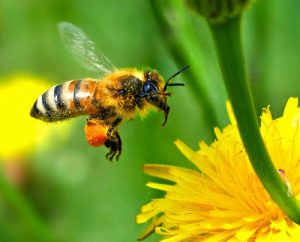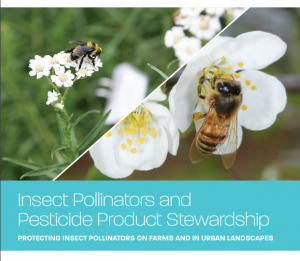Introduction
Pesticides play an important role in controlling insects, weeds, and diseases on farms and in urban landscapes. The areas treated for pests are often shared by pollinators; mainly insects such as bees, butterflies, wasps and flies, and also birds and bats. Pollinators visit flowers in their search for nectar and pollen. During a flower visit, a pollinator may accidentally brush against the flower’s reproductive parts, depositing pollen from a different flower. The plant then uses the pollen to produce a fruit or seed.

“European Honey Bee Touching Down” by autan (flickr.com CC BY-NC-ND 2.0)
Pollinators are essential to the survival of the majority of flowering plants in our environment and to the production of more than 85 crops. Over $15 billion annually is attributed to the value of pollination of food crops, especially fruits, vegetables, and nuts. It is estimated that pollinators are responsible for 1 out of every 3 bites of food that we eat.
Insects are the most common and abundant pollinators. Among the pollinating insects, the honey bee is relied on to perform most of the commercial pollination. As a pesticide applicator, you are critical to reducing pesticide risks to honey bees. Proper pesticide use starts with following the product label. Also, the use of Integrated Pest Management (IPM) and Best Management Practices (BMPs) wherever pollinators are present will prevent harming honey bees, their food sources, water, and habitat.
Although the information in this module is aimed at the protection of honey bees, the stewardship principles and practices described are applicable to all pollinators. The information on this site was reviewed by:
John Allran, Environmental Toxicologist, US Environmental Protection Agency,
Dr. Caydee Savinelli, Pollinator and IPM Stewardship Lead, Syngenta, and
Dr. David Tarpy, Professor and Extension Apiculturist, NC State University.
Technical inputs provided by Wayne Buhler, PhD.
Sources:
 Protecting Pollinators: Why and How Pesticide Applicators Can Help Them. North American Pollinator Protection Campaign.
Protecting Pollinators: Why and How Pesticide Applicators Can Help Them. North American Pollinator Protection Campaign.- How to Reduce Bee Poisoning from Pesticides. L. Hooven, R. Sagili, and E. Johansen.
- Protecting Honey Bees from Pesticides. Malcolm Sanford, Univ. of FL.
- Bee Health: The Role of Pesticides. Congressional Research Service 7-5700.
- Insect Pollinators and Pesticide Product Stewardship. Coalition for Urban/Rural Environmental Stewardship, Syngenta, and Bayer CropScience.
